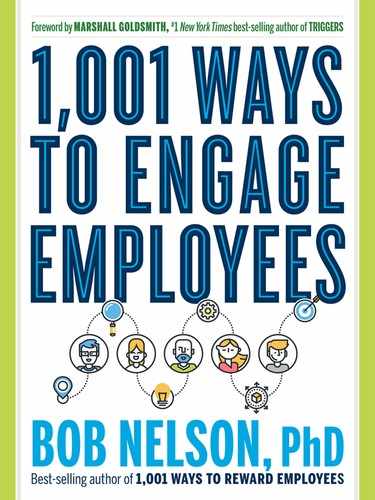AVAILABILITY OF RESOURCES
Make sure people have the tools to do their work! What could be easier? Yet, most employees struggle every day with this challenge in some way.
Once employees know what is expected of them, they need access to all information, tools, and resources to do the best job possible. This is a major challenge given only half of employees report they have the proper equipment to perform their job functions! This sounds extreme until you think about the typical challenges employees have in most any job, for example, waiting for an approval to spend resources on needed office equipment, which in turn is dependent on waiting for the budget to be finalized, which is held up because a key executive is out of the country until later this month, and so on. Or submitting a request to the IT department to make a software change that could save the company time and money, enhance customer service, or improve a work process only to learn that department is backlogged with other software projects for at least seven months. The list can go on and on.
Robert W. Johnston Jr., a clinical quality management analyst at Gateway Health in Pittsburgh, Pennsylvania, makes the case for the importance of resources:
I never knew how much my creativity had been stifled by a lack of resources until I joined my current organization. In a previous role, if I needed a report, for example, I had to submit a formal request to the Report Steering Committee, which was a group of individuals charged with determining if a report request warranted the attention of the IT team. That committee met only monthly, so if you requested a brand new report and were justified in your request, you were lucky to receive the data within six weeks (assuming they approved it).
Now, I log into a web-based portal, which has an option for submitting report requests directly to the IT Team. Once submitted, you are given a request number for tracking purposes. An analyst on the IT team fills the request, provides your data, and closes the ticket. To date, I have never waited more than seventy-two hours for a report. This includes requests with very lengthy and detailed specifications. As a result, I have completed proposals in record time, built entire dashboards from scratch, and analyzed data faster than ever. It is truly amazing what can be accomplished with access to appropriate resources.
In my research on what most motivates employees at work, “autonomy and authority” were top motivators for today's employees. All employees need to have a say in how they do their work to make it more meaningful. When employees find their work to be meaningful, they become more engaged and effective. It's critical that they go beyond their job descriptions to do whatever they can to make a difference not only in their jobs but also for the greater good of the company. Managers can encourage increased autonomy by:
- Allowing employees to approach anyone they need for help.
- Giving them the authority to use resources.
- Permitting them to take the actions that are necessary to get the work done.
Once employees have been enlisted to get involved and make suggestions or improvements, they need to be encouraged to run with their ideas, take responsibility, and champion those ideas through to closure and completion. This chapter will feature numerous examples for how obstacles can be overcome so that materials, equipment, and budget can be provided to employees to do their work more effectively.
You have to organize so people have the authority to do their jobs. But you need enough control to understand what's going on.
—FRANK V. CAHOUET, CHAIRMAN, MELLON BANK CORPORATION
Cara Silletto, president and chief retention officer for Crescendo Strategies in reports:
Our staff are encouraged to find and suggest software we could purchase to make their work easier and faster. Each year, we implement at least one new system to gain efficiencies and streamline our processes.
Managers at Norse, a facilities management firm based in Norwich, England, know that employees who lack resources to perform their jobs will quickly become frustrated and less productive. To prevent this from occurring in their work environment, the company makes significant investments in plant equipment, personal equipment, and protective equipment.
RIVA Solutions in McLean, Virginia, provides the tools and resources for employee collaboration, such as Basecamp, an online project management platform that is designed to share priorities, brainstorm ideas, assign follow-ups, and manage information in a transparent fashion.
Stephen Howard, publisher of Broker World Magazine, attests to the culture of National Life Group: “National Life is doing whatever it takes on the inside to equip people at all levels with the information and resources they need to make good business decisions and offer great service.” They bring in others within the insurance industry, such as brokers and adjusters, to talk to different departments so that employees can understand the business better and be of greater service to customers. National Life also designed a simple profit and loss statement to help all stakeholders make good business decisions and more fully understand what impacts the bottom line.
San Francisco-based coin exchange company Coinbase turns its cafeteria into their Crypto Club where new employees learn the basics of virtual currency.
Convercent, a compliance software company in Denver, Colorado, helps its own employees get quick answers to compliance questions using a chatbot. “When an employee opens the code,” says CEO Patrick Quinlan, “a chatbot appears in the corner to ask ‘Do you have a question?’ Employees can report an issue, access additional resource or ask questions right then and there.”
After discovering that its sales representatives spent only 30 percent of their time in their offices, the real estate department of computer networking giant Cisco Systems decided to fully support the mobility of these employees. By creating a desk-sharing arrangement for its sales representatives, the company was able to decrease its office needs while providing better support to employees. In addition, the changes saved the company $12.6 million over a recent five-year period.
I thought, my God, if I can get people pumped up, wanting to come to work, what an edge that is! That's the whole secret to increasing productivity. I saw them push and accomplish things they never thought were possible. I saw satisfaction on a daily basis.
—JACK STACK, CEO, SRC
Timothy Welch, a chief systems engineer for SaaS PowerDMS, was supported with the resources to travel around the world through a company program called Remote Year. He appreciated SaaS's willingness to allow him to telecommute. They also let employees lengthen their time away from the office by adding remote work options to a vacation. For example, they can go to London on holiday and add a week-long work session in Wimbledon without losing more vacation time.
CASE STUDY: A TEAM APPROACH TO EXCEPTIONAL QUALITY
To achieve their goal of getting a Forbes Five-Star rating for their signature restaurant, Twenty-Eight Atlantic, Wequassett Resort and Golf Club in Massachusetts developed and implemented a new employee training plan.
For prework, front-of-house employees learned everything about the menu, drinks, and the art of providing exceptional service; back-of-house workers learned everything needed to prepare high-quality food. Then Wequassett designed the workshop.
Workshop
The beginning of the workshop reviewed criteria used by Forbes to award its stars. The body of the workshop had two main parts.
In Part 1, the front-of-house group described menu items aloud, and the back-of-house group had to name the item and tell them how best to explain the dish to diners. Servers found the activity inspirational.
In Part 2, the back-of-house team prepared and presented food items to the front group.
After looking over and sampling the dishes, both groups completed an inspection form. Chefs gained an appreciation of the look and feel of dining from the customer's perspective, and needed changes were made in the kitchen.
Results
Guest service index (GSI) scores improved significantly, and after one year, Wequassett achieved its goal when Forbes awarded its Five-Star rating to Twenty-Eight Atlantic. Restaurant revenues increased with a combined 10.29 percent growth in dinner and beverage.
Black & Veatch, an engineering, procurement, and construction company based in Overland Park, Kansas, needed to implement ethics and compliance training for its 11,500 employees located at 100-plus offices and projects in over 100 countries. Because this type of training is often ineffective in other companies, Peter Loftspring, the firm's global ethics and compliance leader, aims to make ethics more visceral. Loftspring says, “I want to make people feel more uncomfortable.” As Forbes writer Patrick Quinlin explains, “The idea is to put people in near-real scenarios in order to show how they would truly feel and react. That way, if and when it happens in real life, they'll know how to make the best choice.”
A group of employees participated in the program. After they donned headsets and accessed the videos via YouTube on their phone, they experienced several compromising ethical situations firsthand. Within a two-week period after the program started, 99 percent of the participants completed it.
We can invest all the money on Wall Street in new technologies, but we can't realize the benefits of improved productivity until companies rediscover the value of human loyalty.
—FREDERICK REICHHELD, DIRECTOR, BAIN & CO.
Marsh & McLennan Companies had a huge challenge when they were planning to launch its new code of conduct. This professional services firm with 60,000 employees worldwide decided they needed to make a movie. But not just any movie. They hired award-winning director Ryan Fenson-Hood to produce a fifty-minute documentary that portrayed five employees from different cultures speaking different languages. Entitled Faces of Marsh & McLennan, the movie showed how these employees addressed several workplace and external challenges. Employees loved the movie, which ultimately helped meet the goal of explaining the new code of conduct across cultures.
Oppenheimer, the wealth manager and investment banking firm based in New York, launched OpcoCentral, a portal to the company's social network and e-learning curriculum. “We're committed to developing and supporting our talent at every level,” says Robert Lowenthal, Oppenheimer Management Committee chairman. OpcoCentral also serves as a dashboard and provides the appropriate technology to support the company's focus on communication and skill development. The site has two components: One is called OpcoUniversity is the e-learning curriculum that rounds out the firm's in-person learning workshops. Employees have immediate access to the online resources twenty-four seven from anywhere in the world. The curriculum also offers elective courses, which employees can learn at their own pace. The second component is called OpcoSocial, a social media platform that gives employees the opportunity to collaborate with others in real time. They can form groups to flesh out ideas with any other employee in the company. Joan Khoury, the company's chief marketing officer, says, “Technology is becoming increasingly critical for financial services organizations, and OpcoCentral empowers employees to reach the level of business agility they need to thrive.”

Online grocery company Ocado uses the Slack communication app, which allows its workforce to send multimedia messages to anyone in the company. Slack's best feature is its “channels,” which contain subchats dealing with specific matters. The app can also be used for small groups and teams to communicate with each other. “Slack allows people to quickly update on a conversation,” says Anne Marie Neatham, the COO. Ocado's employees can establish their own Slack groups, such as Random Lunch, which pairs group members with people they never ate lunch with before. The app also helps to elevate voices. For example, a junior staff member may never raise a question during a meeting with senior management, but with the flat structure of the app, all comments in a channel are given the same weight and presence. “In just over four years it has grown to more than 9 million active weekly users,” writes Madison Darbyshire of the Financial Times, “and 50,000 companies pay for the platform. Clients include NASA, 20th Century Fox, the US State Department—and the Financial Times.”
When AT&T, the telecom giant based in Dallas, Texas, replaced its outdated phones, it needed to retrain 100,000 of its 240,000 global employees. These employees filled roles that would not be necessary in the coming years. To resolve the issue, AT&T developed the Workforce 2020 initiative, which cost over $1 billion. Employees love it, and for the first time ever, AT&T made Fortune magazine's list of the 100 Best Companies to Work For.
Piscataway, New Jersey, heating and air conditioning manufacturer Trane assigns coaches to employees as “guidance counselors” who help them better find their way through the large organization. In one example of how the coaches work, James Freeman, an accounting team leader in the company's plumbing department, had an idea to cut Trane's cost for office lighting. No one would listen to his idea—that is, until his coach stepped in and tutored James in how to better present his case to management. The result? James's idea was approved, and Trane spent $135,000 on energy-saving light bulbs.
In his book Getting Employees to Fall in Love With Your Company, Jim Harris suggests four key strategies to emancipate the action of employees:
- Allow freedom to fail and try again.
- Create freedom from bureaucracy.
- Encourage challenges to the status quo.
- Give everyone input into firing the right customers.
C. Mark Seiley, vice president and managing principal of Dallas architecture firm Leo A. Daly, believes that the best way to equip his eighty-five employees for success and happiness is to give them the physical and emotional tools they need, and then stand back and let them do their jobs. According to Seiley, the physical tools include:
- The best technology, including computers and programs.
- A work environment that is comfortable and that encourages employees to do their best job.
And emotional tools include:
- Motivating employees by giving them opportunities and keeping a positive attitude with them.
- Letting them know that you're there to help them whenever they need it.
- Giving them the freedom to do their work without constantly looking over their shoulders.
- Allowing them the flexibility and freedom they need to generate quality ideas.
Japanese pharmaceutical company Daiichi-Sankyo of Tokyo uses videogames to train many of its salespeople. Employees role play as robots, whose task it is to kill onscreen creatures. When the salesperson shoots and kills a creature, a statement providing information about one of the company's many pharmaceutical products is displayed. According to Debra Asbury, director of primary-care sales training at Daiichi-Sankyo, “Our sales force is made up of a lot of Generation X and Yers. We wanted something that would engage our employees.”
According to Mike Morrison, dean of the University of Toyota, the company “periodically takes people out of their typical office environments and let them develop ideas in places where the pressure is off and they can brainstorm without the demands of the workplace. The company also provides lots of information and reading material on the subject at hand.”
When the going gets tough, some organizations are prepared to meet extraordinary needs because they have developed or cross-trained special teams. For example, when the financial markets got busy, the Charles Schwab company recruited and trained a special team they called Flex Force to help answer phone calls. The Marriott hotel chain cross-trains administrative assistants to help out as banquet servers when they have insufficient staff. Both organizations report improvements in productivity and performance, in addition to saving money.

Maimonides Medical Center in Brooklyn created a new role in the organization called engagement ambassador. To fill the roles, they selected people from a cross-section of management and union employees. Ambassadors have been an important part in explaining the concept of employee engagement to the workforce. They have also helped increase the return rate of completed employee surveys, despite the added challenges of hurdling language barriers and some employees' lack of access to computers. President and CEO Pam Brier says, “We needed to ensure the engagement ambassadors represented key employee segments. They speak the language and have the trust of their peers.”
CRC Health Group's facilities are spread out across the United States, so they used a blend of online activities, virtual learning, and in-person workshops at regularly scheduled leadership meetings to build and sustain momentum while building a culture of engagement.
The online retailer Zappos encourages employees to read books from their library to help them grow both personally and professionally. Many are books that have influenced thinking at Zappos and helped them try new ways of conducting business.
To give employees the chance to learn and fail in a safe setting rather than in the kitchen, Louisville's Kentucky Fried Chicken uses virtual reality to train its employees how to cook. Walmart and Facebook also use virtual-reality training for its employees.
When a challenging or upsetting event, such as a death in the family, befalls their coworkers, employees at Accenture can donate their unused paid time off to colleagues.
In India, 70 percent of business process outsourcing companies, those providing services for companies based in the United States, were on the outskirts of the cities and the work hours were not standard. EXL Service in Noida began providing shared accommodations for its employees and also paid their water and electric bills.
Famed for their company perks, Google is serious about employee morale. Their analysis of their work culture has resulted in new policies. After learning that attrition rates for new mothers had risen sharply, the company responded by providing an enhanced parental-leave policy. This resulted in a 50 percent drop in attrition for new mothers.

CASE STUDY: THE PILLARS OF PERFORMANCE

Johnson County Government engages not only their public servants but also their clients and citizens. Seated in Olathe, Kansas, the government has more than 3,800 employees serving 575,000 residents—the most populous of the state's 105 counties. The foundation of their efforts is called Pillars of Performance, which defines how they perform their everyday work to make the county a community where people want to be, work, and live. The Pillars of Performance, developed as a result of their commitment to public service and high performance, serve as the standard resource employees regularly refer to.
Teri Northcraft, the human resources senior partner, writes:
We encompass Pillars of Performance in everything we do from recruitment to performance measures—Pillars of Performance and Development—which empowers employees to share their goals, priorities, and learning and development interests with each other. This information, such as the Pillars of Performance one sheet, is displayed throughout county buildings from common areas to conference rooms.
We have a program called Leadership Empowers All People (LEAP) through which we have trained well over 3,000 Johnson County employees. We believe that the training has a positive impact on employee engagement.
Empowered Employees
Everything they do is an outcome of keeping a pulse on employee engagement. Departments are empowered to do this in ways that work for them. “To guide each individual and each department,” writes Northcraft, “we created an Employee Engagement Best Practices Playbook as a result of our most recent survey in an effort toward moving the needle.”
They Measure
To make sure their efforts are effective, Johnson County Government surveys employee engagement every eighteen months. They survey new employees and applicants to make improvements on the on-boarding process, and regularly survey exiting employees to track trends to identify and make improvements. “We don't look at engagement as an event; we expect the results to be sieved through and discussed throughout the year,” writes Northcraft. They put tools in the hands of their managers to share departmental feedback and plan continuous improvement with their teams.
Results
Every two years, Johnson County conducts a Citizen Survey to gauge resident satisfaction. Northcraft writes:
We rate higher than the national average on most key perception indicators, with a 95 percent satisfaction rating on quality of life in Johnson County. We are proud of our successes and believe our committed and engaged staff continuously strive to serve our citizens better. We also share budget and financial information on how tax dollars are spent, communications surveys, and our annual report.
Northcraft's group also drafts an annual “Workforce Trends and Analysis Report” to share with the Board of County Commissioners and executive leadership team. The report highlights employee turnover and the importance of engagement to attract and retain employees.



